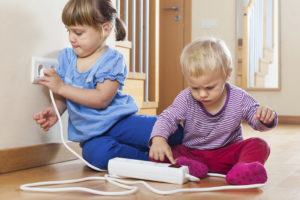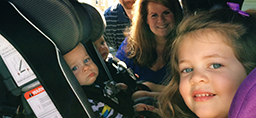
First-time parents are barraged with safety tips from every side.
Lock the cupboards! Cover the outlets! Block the stairs! Lock the windows! Kiss knick-knacks goodbye!
As it turns out, all of that well-intended advice is valuable. Every one of those warnings makes sense.
But home safety isn’t just for new parents, or parents of tiny tots. Until all your kids are grown, Hanna Jaworski, MD, a pediatrician at Spectrum Health Helen DeVos Children’s Hospital, is a strong proponent of regular reviews of your home based on the ages of your children.
“What gets infants and toddlers in trouble is obviously different than for older kids,” Dr. Jaworski said. “We need to use common sense when talking about safety at home. Gates, locks, covers—they’re all smart. But kids are smart, too—and curious, at every age.”
Taking a few minutes to think about what your kids are into now should give you clues about potential pitfalls in and around your house. Be mindful that:
- Infants who can’t move themselves well are vulnerable to suffocation.
- Mobile babies can fall down stairs or hit sharp corners.
- Toddlers might drink or eat anything they can reach, and they can climb into a tub of water.
- Preschoolers are often intrigued by electrical outlets and might try to stick something in the plug openings.
- Elementary-age kids want that “thing” off a shelf that’s too high and don’t always think about consequences to actions.
- Kids of all ages might forget about traffic if a ball flies into the street.
- Tweens may think sports stunts or online friends are safe.
Safety for “littles”
Being a parent who is actively engaged with your child is the most important safety measure you can take.
“You could have everything in the house maxed out for safety, but if you aren’t watching the kids, or engaged with them where they are at risk, something is going to happen,” Dr. Jaworski said, citing baby gates as an example. “Yes, you put the gate up, but did you see your toddler pulling on it or bumping against it? If not, it could dislodge the next time he comes through.”
In her pediatric practice, after-hours calls often require emergency room visits because kids have ingested something.
“For example, a child swallowing a single magnet might not be a big deal, but it must be checked, because if it turns out to be two or more, those magnets will want to go together. That can be deadly,” Dr. Jaworski said. “Or, if the casing on that button battery was compromised in any way, the acid it contains is awful. Not that it happens every day, but it happens.”
Jaworski also encourages parents to look for the hidden dangers in the house.
According to Consumer Products Safety Commission statistics, between 2011 and 2013, 21,700 children required emergency room visits due to tip-overs from furniture and/or TVs. Between 2000 and 2013, the Commission reports 360 child deaths from falling furniture and TVs. The agency notes that the reported number of fatalities “should be considered incomplete, due to a time lapse in reporting to the (Commission).”
Knowing the actual number is even higher, to lose even a single child to a preventable accident such as furniture or TV tip-overs is one too many.
Kids can open drawers of a dresser to climb, for example, or reach and pull. Jaworski advises parents to buy inexpensive straps or bracket systems designed to secure furniture to walls.
Talk to your pediatrician about toys, positioning devices and activity seats. Most doctors try to be in tune to what’s out there.
Jaworski noted that after several years off the market, baby walkers are back on the scene.
Before going out and buying the latest thing or putting your child into a thing, find out if your pediatrician is familiar with any risks. You can also monitor the Consumer Product Safety Commission’s constantly updated childrens product safety warnings and recalls to check the products you see.
Safety for “bigs”
Once again, Dr. Jaworski stresses common sense and your presence as the key factors in keeping kids safe.
“Street safety becomes a concern when your child learns to ride a bike, for example,” she said. “Can that same child safely play in the living room without you? Probably yes. Should you have a watchful eye and ear for your elementary kids playing outside? Absolutely.”
It’s important to know your child, because they are so different.
“I have a son who would leap before he looks,” Dr. Jaworski said. “And he’s curious about nature. I know he would wonder what that leaf tastes like. Would he be at risk for eating a toxic plant? Probably not, but because I know he’s curious about it, I’m going to be watchful over what he wants to eat in the yard.”
Your goal as a parent is to help your kids learn to be good decision makers.
“You can’t protect them forever,” Dr. Jaworski said. “You can’t be everywhere. But when you’re engaged, you’re creating a powerful combination: your presence and the teaching moments that come from being there. I hope my son would think, ‘Mom said this leaf might make me sick, I better not try it.’ It’s those opportunities that lead them to stay safe when you are not there.”
Safety for tweens and teens
Jaworski’s advice to parents of older kids is to zero in on independence-related dangers. If you have a 14-year-old daughter who is on the Internet a lot, who is she talking to, what is she doing? If they are going to drive soon, is your family culture one that always buckles up? What about texting?
It’s also critical to know your kids’ friends and be clear about personal safety. Keep an open relationship. It is not OK to drink alcohol, for example, but if they’ve been at a party drinking, it’s more than OK to call for a ride.
Yes, it’s mostly about you being engaged. It’s easy to get busy with work, chores and demands. But taking a “T” for time out and assessing whether you are prioritizing safety at home just might be the best thing you can do for your family today.
 /a>
/a>
 /a>
/a>
 /a>
/a>